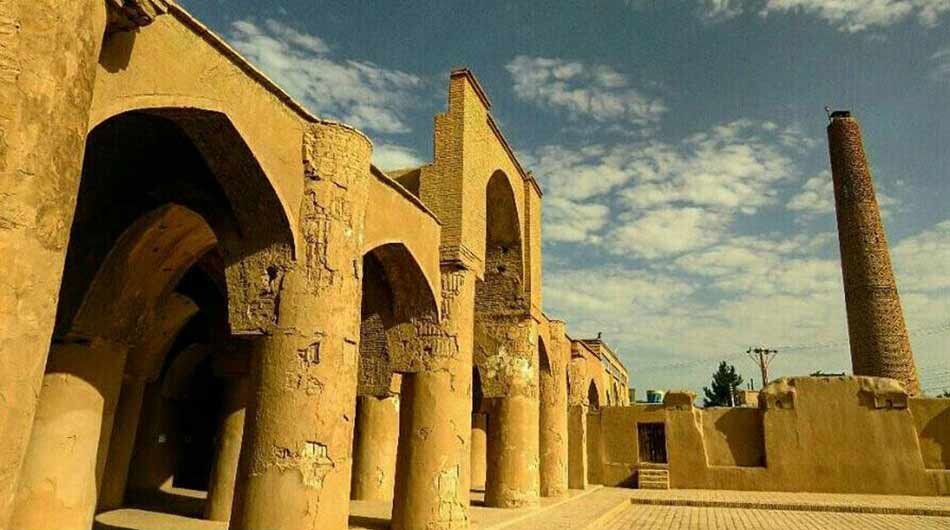Discover the wonders of Damghan: from caravanserais to mosques and forts

TEHRAN - Abundant with remnants of the past caravanserais, strongholds, brick towers, edifices, and places of worship, Damghan can hardly be overlooked by a cultural tourist.
Situated some 350 km east of Tehran, Damghan has long been a giant hub for the culmination of pistachio sometimes referred to as “happy nuts” because they look like they’re smiling.
Narratives say the city’s name is derived from ‘Moghan’, which in Persian refers to practitioners of ‘magos’, or magic, and includes astrology, alchemy, and other forms of esoteric knowledge. In fact, the city was initially called ‘Dah Moghan’, meaning ten magi, which ultimately evolved to its current name Damghan.
For history buffs and researchers, Damghan is a gateway to Hecatompylos, which was the site of the Parthian capital during the ascendancy of the Arsacid of Media dynasty after the capture of the city by Alexander the Great.
Moreover, it was an important trading post of the Silk Roads, on the way from Merv to the Mediterranean coast, according to the book International Dictionary of Historic Places.
Damghan’s travel destinations include Tepe Hessar, old city Fortification, Tarikhaneh Mosque, Seljuk-era architectural gems, Chehel-Dokhtaran, Ismaili fortresses, Cheshmeh-Ali, along with some natural gems.
Tarikhaneh Mosque
Still in its original shape, the mosque of Tarikhaneh is the oldest mosque in Iran belonging to the 1st century after the birth of Islam. Tarikhaneh in southeast Damghan and the historical mosque of Naeen city in Isfahan Province are the only mosques before the Seljuk era when the archetype of Iranian mosque architecture took form.
The building material and architecture of the mosque is of Sassanid style, quite analogous to Sarvestan Palace at 90 km southeast of Shiraz, and the Palace of Ardeshir in Firuzabad of Fars.
Due to the plan and architecture of the building, some believe it was a fire temple during the Sassanid period before it was replaced by the existing mosque.
Tarikhaneh Mosque has a square yard and a gallery of 18 columns facing Qibla, the direction of Ka’ba in Mecca. Three sides of the yard are surrounded by porticos. The minaret rising over the mosque is said to belong to the Seljuk era. The tiled inscription over the minaret is the oldest tile work in Islamic architecture. Tarikhaneh is comprised of two words: Tari and Khaneh. Tari, Tanri, Tengri, Tangri, or Tenger literally meaning sky or heaven, is a Turko-Mongol god, identified with Allah by early Muslims of the region. The latter part, khaneh, means house or place. Thus, Tarikhaneh can be translated as the house of God.
Tepe Hessar
Of the historical treasures in Damghan one must refer to the valuable Tepe Hessar which is thought to be an ancient garrison. Prof. Hertzfeld between 1931-1933 and Dr. Schmidt from 1933-1938 were the first archaeologists who explored the site.
Tepe Hessar with several layers of civilizations has a long history. The layers include settlements of the Medes dynasty and Achaemenid era, as well as the Parthian and Seleucid periods when the site saw its best days.
Historical excavations have shown that the history of Damghan starts between the 5th and 4th millennium BC. Carbon 16 isotope inspections in Tepe Hessar have revealed an age of 7,000 years for some artifacts.
Old city fortifications
Walls, fortifications, and battlements have survived in many parts of Damghan. As mentioned in historical sources, the walls were wide enough to let chariots run atop. The remains of such walls can be seen in the north and south of Damghan.
Seljuk-era architectural jewels
The Seljuk era has left behind architectural treasures in Damghan: the shrine of Pir-Alamdar ‘old flag-bearer’; Masjid Jame’ or congregation mosque and its minaret; Mansurkuh village; the tower of Jafar’s tomb; and the vault of Chehel-Dokhtaran ‘40 girls’. For the first time in Iran, the brickworks of the monuments are adorned with decorations to compensate for the monotony and repetition.
Chehel-Dokhtaran, a family vault
The vault of Chehel Dokhtaran is located at the center of Damghan and behind Jafar’s tomb. According to the Kufic inscription in the edifice, the vault was built in 1087. Though the city lies on an earthquake belt, the vault has survived without cracks.
The onion-shaped dome of Chehel-Dokhtaran is adorned with artistic brickworks and inscriptions. The building which used to be a family vault is 14.8 meters high. In its famous inscription, the deceased has sought divine mercy and blessing.
Cheshmeh-Ali
Cheshmeh-Ali, 30 km north of the city, is one of the permanent springs in Damghan. Thanks to verdant foliage and pleasant climate this region has been frequented by people from ancient times. During the Qajar period, many buildings were constructed in Cheshmeh-Ali among which the palaces of Fath-Ali Shah and Aqa Mohammad Khan still stand. Fath-Ali Shah’s palace is built in the middle of a lagoon, between the first and second springs; across from Aqa Mohammad Khan’s palace.
Ismaili fortresses
There are two Ismaili forts built on top of two mountains, north of the city, belonging to the then esoteric sect of Ismailism.
The first, being 5 km off the city, is on the summit of Gerdkuh mountain. The second, known as Mehrnegar Fort, is on Mansurkuh mountain, 22 km north of Damghan.
AFM
Leave a Comment